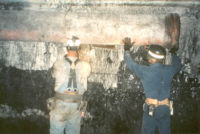Site visits, task analyses, and interviews suggest that the majority of the risk exposure associated with materials handling in mining operations results from the lack of properly designed and easily accessible materials handling tools, devices, and vehicles. Mine personnel traditionally rely on a "couple of extra hands" or on crowbars, come-alongs, and other makeshift tools to handle even the largest components of mining machinery. Similarly, lacking appropriate tools, carts, and other handling devices, mine personnel manually move timbers, posts, beams, and other heavy materials on a continual basis. In most instances, tools are simply not available for these heavy lifting, transporting, and positioning tasks. The work in this topic area is supported by the NIOSH Mining Ergonomics and Materials Handling programs. See the NIOSH Mining Products page for software, guides, training materials or other items related to this topic. |
Engineering controls
Ideas to Reduce WMSDs (HTM, 1997)
A range of ideas to deal with Work Related Musculoskeletal Disorders (WMSDs) from miners, mining safety professionals, and NIOSH research.
Inexpensive, Easy to Construct Materials-handling Devices for Underground Mines (PDF, 8693 KB, 1994)
The U.S. Bureau of Mines developed and tested designs for six materials-handling devices for use in underground mines to reduce materials-handling injuries. Particular attention was focused on making the designs practical, low cost, and easily fabricated. The devices include scoop-mounted lift boom, swing-arm boom, heavy component lift-transport, mine mud cart, container-work station cart, and timber car.
Materials Handling Accident Reduction in Underground Mines (PDF, 5347 KB, 2001-09)
Handling materials in underground mines continues to be a major safety problem. To reduce single-event lift injuries, equipment having mechanical automatic weight sensing and balancing control was investigated. The Coleman manipulator was selected for testing. Modifications were made to make it more suitable for underground mine use. The authors also discuss other innovative ways to improve materials handling.
Methods To Minimize Injuries in Materials-Handling and Processes in Underground Mines (PDF, 4902 KB, 2002-02)
Data from the Mine Safety and Health Administration for the years 1989-1999 were studied to find out if there were any trends in materials-handling accidents and if so, to determine what tasks were involved and the sources of injuries. Several underground coal and metal mines were visited to document innovative materials-handling technologies. Considerations for safety training and mechanization needs for continued reduction in materials-handling injuries are described.
Reducing Materials-Handling Injuries in Underground Mines (PDF, 3453 KB, 2001)
This paper examines Mine Safety and Health Administration accident data to determine correlations between materials-handling tasks and the number of back injuries. It also discusses technologies used in U.S. underground mines to reduce the risk of injury. A Coleman manipulator was tested, and modifications were made to make it more suitable for underground mine use.
Technology News 521 - Development of a Mobile Manipulator to Reduce Lifting Accidents (PDF, 97 KB, 2006)
Discusses a first-generation mobile manipulator that one person can use to lift and maneuver 50- to 600-pound loads. It can be used in maintenance shops and mines to reduce lifting accidents.
Mobile Manipulator: A device for lifting and maneuvering loads up to 600 pounds
CDC/NIOSH has developed a prototype device designed for one person to safely and effectively lift and maneuver loads up to 600 pounds for a variety of materials handling tasks in maintenance shops.
Information gateways
Ergonomics and Musculoskeletal Disorders
Includes information about musculoskeletal disorders, back belts, ergonomics programs, selection of hand tools, evaluation of lifting tasks, and other topics.
| Musculoskeletal diseases and disorders | |
| Ergonomics | |
| Haulage |
